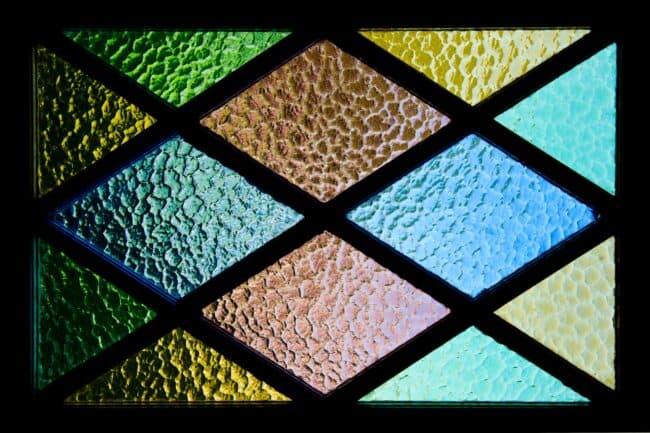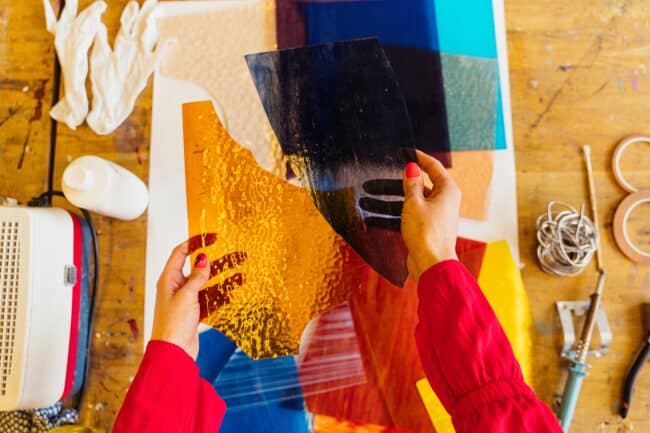Getting Started Making Handmade Stained Glass
Stained glass is a craft and hobby that has been practiced for generations.
You may be familiar with the intricate stained glass patterns in churches and grand homes, which have taken expert craftsmen many hours of work and experience to create.
But stained glass can be used in smaller projects for your home – such as windows, door panels, and wall art.
You can create some beautiful pieces for your home, and learn a classic craft and find a new hobby too.

This post contains affiliate links. This means that if you click on a link in this post and make a purchase via that link I may receive a small commission, at absolutely no additional cost to you.
What is Stained Glass?
Stained glass is a type of decorative glass that is typically used in windows, doors, and other architectural elements to create colorful and intricate designs.
It is made by adding various metallic oxides to the glass during the manufacturing process to create different colors.
These colored pieces of glass are then arranged to form patterns, images, or scenes, which are often seen in churches, cathedrals, and historical buildings.
The term “stained glass” refers to the way the glass is colored or stained, rather than being painted or printed.
The colors in stained glass are produced by the interaction of light with the colored glass itself, creating a vibrant and luminous effect.
Stained glass windows are known for their artistic and decorative value, and they have been used for centuries to enhance the aesthetic and spiritual aspects of architectural structures.
Why Stained Glass is a Great Hobby Craft to do
Stained glass is a great hobby and craft to learn and do for so many reasons:
- Creativity: Stained glass allows you to express your creativity by designing and creating unique and beautiful pieces of art. You have the freedom to choose colors, patterns, and designs that reflect your personal style and artistic vision.
- Relaxation: Working with stained glass can be a calming and meditative hobby. The process of cutting, shaping, and assembling glass pieces can be a therapeutic and stress-relieving activity.
- Learning Opportunities: Stained glass hobbyists often enjoy learning new techniques and skills. It offers the opportunity to develop proficiency in glass cutting, soldering, and glass artistry. You can continually challenge yourself with more complex projects as you gain experience.
- Tangible Results: One of the rewarding aspects of stained glass as a hobby is that you get to see tangible results. You create beautiful pieces of art that you can display in your home or give as gifts to friends and family.
- Connection to History and Tradition: Stained glass has a rich history, with examples dating back to ancient times. By practicing this craft, you can connect with a centuries-old tradition of craftsmanship and artistry.
- Social Engagement: Stained glass can also be a social hobby. You can join stained glass clubs or take classes where you can meet like-minded individuals who share your passion for the craft.
- Home Improvement: Stained glass projects can be used to enhance your home’s décor. Stained glass windows, lampshades, or other decorative items can add a unique and beautiful touch to your living space.
- Sense of Achievement: Completing a stained glass project can give you a strong sense of accomplishment. It’s satisfying to see a finished piece that you created with your own hands.
- Therapeutic Value: The process of working with stained glass can be therapeutic and provide a sense of focus and concentration. It can be a way to unwind and disconnect from the stresses of everyday life.
- Preservation of Skills: Stained glass is a traditional art form that benefits from the preservation of skills and knowledge. By taking up this hobby, you contribute to the continuation of a valuable craft.

How Hard is it to Learn to Make Stained Glass?
- Artistic Background: If you have prior experience with art, such as drawing or painting, you may find it easier to grasp the artistic aspects of stained glass design. Understanding color theory and composition can be beneficial.
- Craftsmanship Skills: Stained glass involves cutting and shaping glass, soldering, and other hands-on skills. If you have experience with similar crafts like woodworking or jewelry making, you might adapt more quickly to the techniques used in stained glass.
- Patience: Stained glass work can be intricate and time-consuming. You need to be patient and detail-oriented, especially when cutting and assembling pieces.
- Training and Resources: Taking classes or finding instructional materials can significantly accelerate your learning process. Many communities offer stained glass classes, and there are plenty of books, online tutorials, and videos available.
- Practice: Like any craft, practice makes perfect. The more you work with stained glass, the more skilled you’ll become. It’s important not to get discouraged by initial challenges.
- Tools and Equipment: You’ll need the right tools and equipment, such as glass cutters, grinders, soldering irons, and safety gear. Learning to use these tools safely and effectively is part of the learning process.
- Start with Simple Projects: It’s a good idea to begin with straightforward projects, such as small sun-catchers or simple panels, before tackling more complex designs.
- Design Skills: Creating your own stained glass designs can be challenging. Some beginners start by working with existing patterns and gradually move on to designing their own.
How to Learn how to Make Stained Glass
By far the best way to learn how to work with and create with stained glass is to take an in-person class. In-person classes can let you learn hands-on with experts who can help you troubleshoot too.
An in-person class will also provide a lot of the supplies needed for stained glass making (you may have to provide some of your own or pay a charge for some supplies).
This can be great if you are not sure you are going to like stained glass creating, or if you don’t want to buy all supplies up front to learn the craft.
There are numerous supplies needed for stained glass making, and many of those supplies are not cheap. So I would encourage you to read first what is entailed with stained glass making, and the supplies needed, before you jump into this craft.
There are also online classes in stained glass design and creation, which can be good, but you cannot get the valuable help and guidance that you get in in-person classes. But if an in-person class is not available in your area, these are a good option.
You can also self-teach yourself by watching videos, such as YouTube videos on stained glass making. However, be careful with safety when you are teaching yourself.

Workspace Needed for Working with Stained Glass
Because of the nature of making stained glass projects – cutting, grinding, soldering etc, it is best to have a dedicated workspace for this.
You need a sturdy table to work bench to work on, as well as enough space to work, and space to store your supplies too. Drywall slabs are great for cutting on. For smaller stained glass projects these heat-resistant stained glass work surfaces are great.
Cold glass also doesn’t cut as well, so a workspace that is climate controlled is best – where you can use a heater if it is too cold.

Supplies Needed for Stained Glass
Heads-up – this list is extensive!
Essential Stained Glass Supplies:
Glass
Large Self-Healing Cutting Mat
Transparency Sheets
Scissors
X-acto Knife & Blades
Glue Stick
Sharpie marker
Ruler
Rubbing Alcohol
Paper Towels
Patterns
Layout Block System for Stained Glass (you may need a lot of these for larger projects)
Grozer Pliers & Glass Running Pliers & Grip Oil Feed Glass Cutter Set (these all come in a set here)
Glass Cutting Oil
Right Angle or T-Square
Small Hammer
Copper Foil & Foil Burnisher
Grinder & Grinder Bits & Grinder Coolant
Safety Goggles & Dust Mask
Weller Soldering Iron & Solder
Old rags
Q-Tips
Clarity Stained Glass Finishing Compound
Ruby Fluid Flux
Kwik Clean
Patinas
Copper Came
Saw
Fid Pack
Things that are not essential but would be nice to have:
Table Foiler
Silicone Trivets
Small Laminator
Glass Organizer
Cricut

Safety when Working with Stained Glass
Glass can cut – any size of glass can cut you. Always pay full attention to what you are doing, and always be aware of the potential for harm when working with stained glass or glass of any kind.
Always wear safety goggles when cutting and grinding glass. Small pieces or shards can easily break off and can fly into your face.
Always wash your hands after working with lead and glass, to ensure that there is no lead residue on your hands that can be absorbed into your skin. Glass powder and shards can also be on the surface of your skin.
Wear a dust mask when doing stained glass projects. Dust and particles can break off during the cutting, grinding and soldering process, and you don’t want to inhale these.
Soldering irons can easily burn you. Be careful when working with a soldering iron and soldering. Store the hot iron in a safe place.

Stained Glass can be a great creative craft and hobby to learn, and you can produce so many amazing pieces for your home too.
It is a rewarding craft and hobby, but an expensive one too! So read up on all you need to know before you start to learn to design and create with stained glass!
